Pigeon and dove infestations are becoming an increasingly common problem in our cities. Species of pigeons and doves that just a few decades ago were not present in our territory (or were only present in forests, crops, and rural areas) have migrated to urban environments.
Pigeon and dove infestations thrive in cities. In urban settings, these birds find easy access to food, numerous sources of water, nesting areas, and a lack of predators. All of this contributes to the rapid growth of their populations.
The three most common pigeon and dove infestations are:
Other species of pigeons and doves also present in Spain, but not as common, include:
Rock Pigeon Infestations – The most common pigeon species in cities
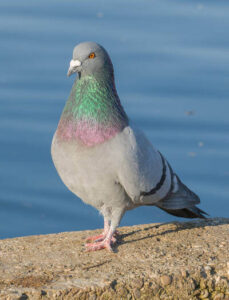
The most common pigeon infestation in our cities is that of the rock pigeon (Columba livia), also called the domestic pigeon.
It is the typical urban pigeon that we see in cities everywhere. It is gray in color and can be easily distinguished from other pigeon species by the two black lines that can be seen on its wings when perched.
To nest, reproduce, and protect themselves from the cold in winter and excessive heat in summer, these pigeon infestations usually choose old or abandoned buildings, roofs of industrial warehouses, or terraces of vacant apartments…
The main reasons why these pigeon infestations are increasing their population in cities are:
- Rock pigeons become fertile at six months of age
- They lay numerous clutches per year, from March to October
- They are perfectly adapted to urban environments
- In cities, they easily find the food, shelter, and water they need to survive and reproduce
Wood Pigeon or Ring Dove – The pigeon species that migrated from the countryside to nest in the city
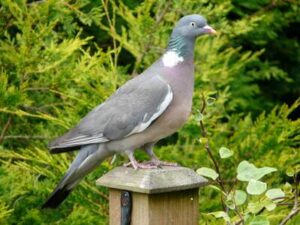
The wood pigeon, or simply ring dove (Columba Palumbus), is easily recognizable because it has a characteristic white patch on both sides of its neck.
The wood pigeon was, until recently, a species typical of the countryside, impossible to spot in cities. However, for the past few decades, the wood pigeon has migrated from the countryside to the city, becoming, like the rock pigeon, an urban pigeon species.
Like rock pigeons, wood pigeons nest and reproduce in the city. But, unlike rock pigeons, wood pigeons usually feed in the countryside. In cities, you can see flocks of wood pigeons that leave for nearby fields in the mornings in search of food: acorns, seeds, cereal grains, plant buds…
Eurasian Collared Dove Infestations – Still more of a countryside species than a city dweller
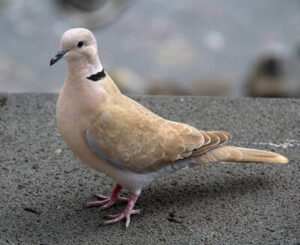
The Eurasian collared dove (Streptopelia decaocto) is easy to distinguish from other pigeon species because it has a creamy color and a characteristic black patch on its neck.
The Eurasian collared dove arrived in Spain in the 1970s. It has achieved a significant population increase and now we can find infestations of Eurasian collared doves throughout the Iberian Peninsula, including the Balearic and Canary Islands, where they cause significant damage to crops.
The Eurasian collared doves, like the wood pigeons, have migrated from their original habitat in the countryside. Now it is not uncommon to find them in city parks.
Stock Pigeons and Common Turtledoves – Less common species in cities
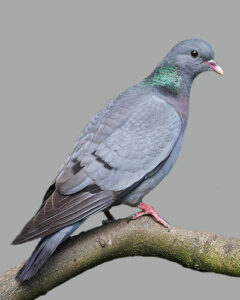
The stock pigeon (Columba Oenas) is bluish-gray in color. Unlike the rock pigeon, it does not have two black lines on its wings. And, unlike the wood pigeon, it does not have white patches on its neck. The stock pigeon is one of the species present in Spain, but it is not as common in cities.
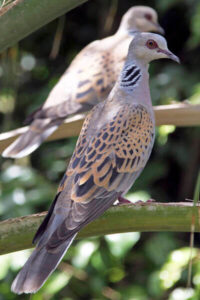
The common turtledove (Streptopelia Turtur) or European turtledove is identified by the alternating white and black lines on its neck and orange and black patches on its wings. Like the stock pigeon, it is present in Spain but is less common in urban areas.
Problems caused by pigeon and turtledove infestations in cities
The adaptability that pigeons and turtledoves have achieved to survive in urban environments has facilitated their proliferation in cities.
Pigeon and turtledove infestations cause many problems in cities: dirt and damage to buildings, cars, sidewalks… and even public health problems.
More information on how to scare away pigeons
- How to repel pigeons. Good advice on the best anti-pigeon products to use in each case.
- Customer Reference – Inasur – Industria Avícola Sureña S.L. explains the problems they had with birds entering one of their warehouses and how they solved them.
- Customer Reference – Lourdes, from Pamplona shares her experience with the anti-pigeon repellent “AviFin Liquid”, to prevent pigeons from perching on windows.
- Problems with pigeons perching on antennas? Discover a good solution: the Eolo Scarecrow for Antennas.
- Pigeon droppings are an aesthetic and health issue. This article explains how to avoid pigeon droppings and how to clean them.
- Not all owl scarecrows are the same. This article provides two good tips for choosing an effective Owl Scarecrow.
- Discover what a Hawk Kite Scarecrow is and how it works.
